NRAO eNews
Volume 7, Issue 11
29 October 2014
NRAO eNews
Volume 7, Issue 11 • 29 October 2014

Upcoming Events

Revolution in Astronomy with ALMA - The Third Year
Dec 08 - 11, 2014 | Tokyo, Japan

Next Generation Very Large Array Workshop
Jan 04, 2015 | Seattle, WA

Splinter Session: New Capabilities at the NRAO
Jan 06, 2015 | Seattle, WA

NRAO Town Hall at the 225th AAS Meeting
Jan 06, 2015 | Seattle, WA
The Extreme Ends of Star Formation: ALMA Detections of the ISM in the Early Universe
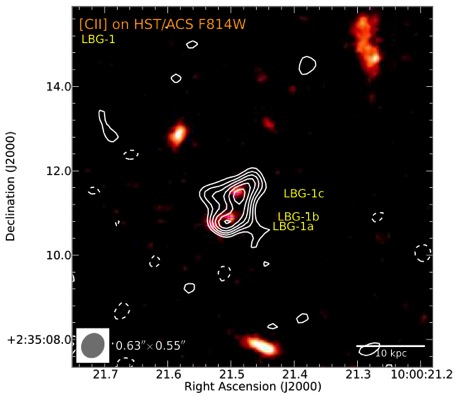
Contours of [C II] emission from the Ly-break galaxy group at z = 5.3. The [C II] contours are superposed on an HST/ACS image of the field.
[click to enlarge]
In a recently accepted Astrophysical Journal article, Dominik Riechers (Cornell) and his collaborators present ALMA observations of the z = 5.3 submillimeter galaxy (SMG) AzTEC-3 and a group of nearby Ly-break galaxies (LBG-1a, 1b, 1c: see Figure) with a projected separation of ~ 95 kpc from the SMG. At such a redshift, much of our knowledge to date about the star formation and ISM properties of galaxies is based on observations of the hosts of luminous quasars and SMGs such as AzTEC-3, but these new observations clearly show the power of ALMA in also detecting the ISM of relatively normal galaxies just 1 billion years after the Big Bang.
The authors detect 158 micron [C II] – which is significantly brighter in galaxies than the CO transitions and can comprise up to 1% of the total far-infrared luminosity – and the 163 micron OH emission lines from the SMG, as well as rest-frame, far-infrared dust continuum emission. The [C II] line emission has an extent of 3.9 kpc, which translates to an enclosed mass of 9.7x1010 M⊙ and a star formation rate surface density of 530 M⊙/yr/kpc2. This high surface density, combined with its low, local ULIRG-like [C II]-to-far infrared luminosity ratio, suggests that AzTEC-3 is an extreme, compact starburst system operating close to the limit where radiation pressure from stars on dust grains in an optically thick environment can halt star formation.
In contrast, while the ISM of the group of Lyman-break galaxies is detected in the form of [C II] emission (see Figure), no far-infrared continuum emission is detected. The upper limit of the continuum emission, when combined with pre-existing shorter wavelength observations of Lyman-break systems, is sufficiently constraining to show these galaxies to have a ultraviolet-to-far infrared spectral energy distribution shape consistent with local dwarf galaxies. Further, the upper limit on the star formation rate of less than 18-54 M⊙/yr, calculated from the far-infrared luminosity, is in the range of the ultraviolet luminosity-estimated star formation rate of 22 M⊙/yr.
ALMA Project Status

More than 150 refereed ALMA papers have appeared in the literature, garnering over 1500 citations. Nine new papers appeared in journals in September. More than half of the Cycle 0 data have been published. Many new science results have been submitted for presentation at the Revolution in Astronomy with ALMA - The Third Year conference that will take place 8-11 December 2014 at the Tokyo International Forum in Tokyo, Japan. The Scientific Organizing Committee has selected 60 submissions for presentation. The preliminary science program is at the website.
The automated ALMA calibration pipeline was accepted and put into use, as announced on the ALMA Science Portal. Experts at the Joint ALMA Observatory (JAO) and the ALMA Regional Centers (ARCs) will continue to process some new observing modes that are not yet seamlessly handled by the pipeline and a few data on which the pipeline still balks. For now, imaging and packaging of all data continue to be done manually by the JAO and ARC experts.
Extended capabilities testing for the ALMA Cycle 3 Call has continued with a special campaign focusing on baselines out to at least 10 km. Regular Early Science observations with the 12 m array have been suspended (these observations are carried out on a shared risk basis). A status report on the extended capabilities testing will soon be published at the Science Portal. The ALMA Cycle 3 Call for Proposals will be published in about five months.
The Long Baseline campaign is going well. Antennas populate a significant number of distant stations on baselines up to 14 km, including the most remote stations on the south and west ends of the array. After the conclusion of the long baseline campaign at the end of November, antennas will be moved to the most compact array for the resumption of Early Science observing. An assessment of the maturity of new capabilities will occur in early December, and a Cycle 3 pre-announcement including planned observing modes and a timescale will follow. Early Science observing will continue until observations are suspended by the altiplanic winter and its historically lower quality observing conditions. Engineering and software projects will continue in February and March 2015, as may some science observing for testing purposes, as conditions permit.
A news item detailing the current status of ALMA observations will be available at the ALMA Science Portal by 1 November.
AAS Workshop: Next Generation Very Large Array

New Worlds, New Horizons laid out an ambitious panorama of astronomical discovery for this decade. Radio astronomy is playing a leading role in opening this discovery space, with telescopes such as the Jansky VLA, ALMA, and the GBT in the vanguard. Radio telescopes are imaging the earliest phases of planet formation, studying the cool dust and gas that drive star formation in galaxies across cosmic time, observing energetic and time varying phenomena ranging from compact stars to distant AGN, and testing the fundamental laws of physics and cosmology.
As we approach the mid-point in the decade, and anticipating exciting new observational capabilities from instruments like the Square Kilometre Array and the James Webb Space Telescope and TMT, the NRAO invites the community to consider the future of radio instrumentation in the coming decade, and beyond, at a one day workshop preceeding the AAS January meeting in Seattle. This Workshop, organized by NRAO and envisioned as the first in a series, is designed to broaden our discussions with the community, develop a deeper understanding of the future science opportunities at meter to submillimeter wavelengths, and foster new interactions with the US university community. This Workshop will include discussion of the scientific and technological opportunities and challenges in cm radio astronomy, as well as US and international interests in producing powerful new capabilities for the astronomy community.
The focus of this workshop will be on the scientific impact of a facility operating in the few cm to few mm regime with a substantially larger (factor 5 to 10) collecting area, and improved spatial resolution relative to the current VLA. Such a facility will open a new window on imaging cool thermal objects in the Universe at milliarcsecond resolution.
The Workshop will be an open forum for the discussion of new and expanded science areas for cm radio astronomy – a future science case. An important outcome of this meeting will be identifying the technological and operational developments that will be needed in the next decade to enable scientific progress. To facilitate and organize the discussion, working groups have been established to consider key science programs that could be addressed. The four working groups are:
- Cradle of Life: (proto-)planetary systems and formation; cloud cores to stars; astrochemistry/biology; Solar System; SETI
- Galaxy Ecosystems (baryon cycle): Galactic structure; interstellar medium and star formation; star formation laws, nearby galaxies; outflows and inflows; supermassive black holes (SMBHs)
- Galaxy Assembly through Cosmic Time (high z Universe): cool gas and dust; dynamics; Active Galactic Nuclei (AGN)/SMBHs
- Time domain, Cosmology, Physics: Transient sky; synoptic surveys; AGN physics; high energy phenomena; stellar phenomena; pulsars.
The Workshop will consist of invited talks by world experts in the field, breakout sessions, report-outs by the working groups, and open discussion. These working groups will be community-led, and we are hoping for strong participation from the US and international astronomy community. If you are interested in participating, please register on our workshop website.
Scientific Organizing Committee
- Juergen Ott (chair, NRAO), Tony Beasley (NRAO), Bryan Butler (NRAO), Chris Carilli (NRAO), Joe Lazio (JPL, CIT), Betsy Mills (NRAO), Emmanuel Momjian (NRAO), Karin Öberg (Harvard), Dominik Riechers (Cornell).
AAS Splinter Session: New Capabilities at the NRAO
Seattle – AAS Meeting
Tuesday, 6 January 2015
01:30 – 03:30 pm PST
Washington State Convention Center, Room 303

NRAO scientific staff will host a Splinter Session at the January 2015 American Astronomical Society (AAS) meeting in Seattle that is designed to assist members of the astronomical community who may be new to radio-wavelength observations. This Splinter Session will showcase the cutting-edge capabilities available at the four state-of-the-art NRAO telescopes: the Green Bank Telescope (GBT), Jansky Very Large Array (VLA), Very Long Baseline Array (VLBA), and Atacama Large Millimeter/submillimeter Array (ALMA).
Following short talks highlighting exciting science that can be done with each telescope, attendees will have the opportunity to chat informally with NRAO experts about science, observing proposal ideas, and synergies with other facilities. NRAO staff members will also provide hands-on assistance for persons interested in GBT, VLA/VLBA, and ALMA observing proposals in advance of the 1 February 2015 GBT-VLA-VLBA and spring 2015 ALMA Cycle 3 proposal deadlines.
To use the NRAO proposal preparation and observing tools during this Splinter Session, you will need an NRAO account. If you do not have one yet, please sign up online. No previous radio-wavelength experience is necessary to attend and benefit from this Splinter Session, and we strongly encourage new and potential NRAO facility users to attend. For questions or comments, please contact Alison Peck.
The planned talks for this session are:
| Talk | Speaker | Duration |
|---|---|---|
| GBT Capabilities and New Instrumentation | Jay Lockman | 15 minutes |
| The Jansky VLA and the VLBA: Capabilities and Recent Developments | Emmanuel Momjian | 25 minutes |
| New Observing Modes for ALMA Cycle 3 | Jennifer Donovan Meyer | 15 minutes |
AUI President Receives North American-Chilean Chamber of Commerce Award
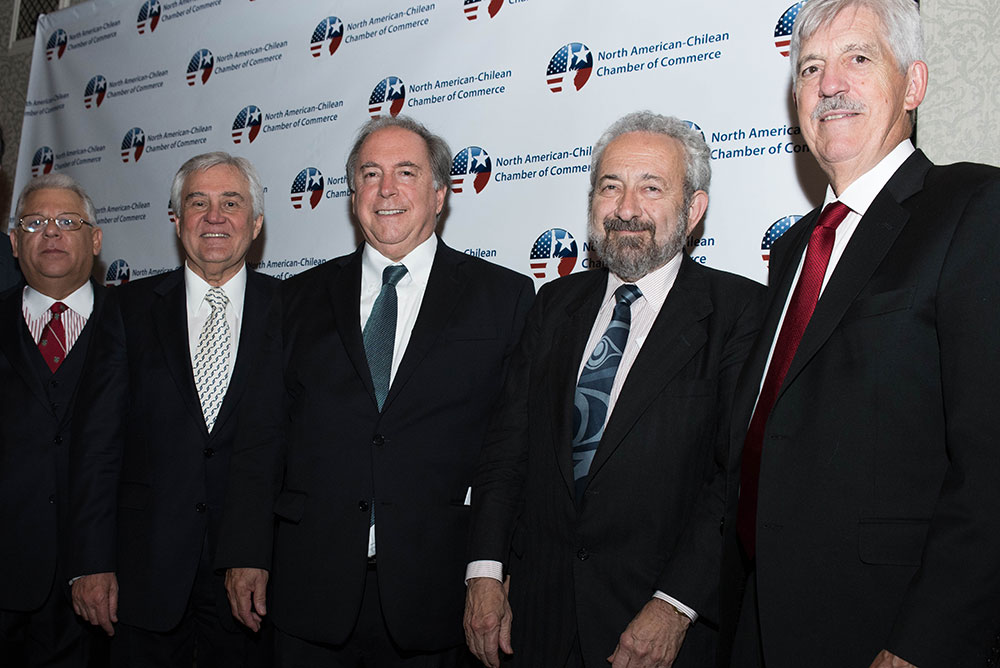
Robert Braunfeld
[click to enlarge]
In a ceremony held on 22 October in New York City, Associated Universities, Inc. (AUI) President Ethan Schreier received the Distinguished Scientist of the Year award from the North American – Chilean Chamber of Commerce in recognition of the work AUI and NRAO have done in Chile for ALMA. Other awardees included Roberto Angelini Rossi, the President of Empresas Copec S.A., who was recognized as a Distinguished Corporate Leader; and John Dinges, Godfrey Lowell Cabot Professor of Journalism at Columbia, who was recognized as a Distinguished Honorary Chilean.
In photo, from left to right: Mario J. Paredes, Chamber President; Roberto Angelini Rossi; Juan Gabriel Valdés, Chilean Ambassador to the U.S.; Ethan Schreier; and John Dinges.
WVU Seniors Engaging in GBT Development
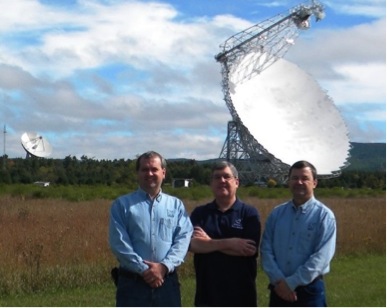
NRAO Green Bank supervisors
[click to enlarge]
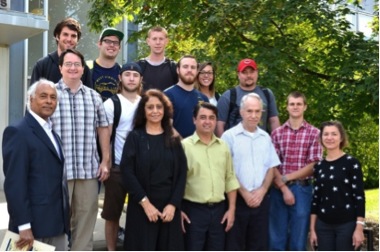
WVU seniors and their faculty supervisors who will be working on GBT projects
[click to enlarge]
NRAO and West Virginia University (WVU) are committed to science, technology, engineering and math (STEM) education, and, in particular to “priming the pipeline” for the next generation of professional scientists and engineers. In 2012, WVU announced its Mountains of Excellence program for strategic research investments in fields with substantial potential for growth and return on investment, such as international leadership in radio astronomy. NRAO already has strong connections with the WVU Physics and Astronomy Department, and has recently been working to increase its ties to the Lane Department of Computer Science and Electrical Engineering (CSEE).
In September 2014, as part of this initiative, three engineers and a scientist from NRAO – Green Bank travelled to Morgantown, WV to present potential project ideas to the CSEE 480 Senior Design students. CSEE 480 is a two-semester class in which students perform detailed design and implementation of a complete, real-world project. Proposed projects included an “artificial pulsar” test fixture for testing advanced pulsar instrumentation at the Green Bank Telescope (GBT), upgrades to the GBT feed arm servo controllers, and an upgrade to the GBT active surface actuator control system that maintains the telescope focus at high frequencies.
Ten seniors in a class of 77 chose to work on these GBT development projects. These students represent Electrical Engineering, Computer Science, and Computer Engineering interests and majors, and will be organized as interdisciplinary teams. The students will work on these projects throughout the academic year, co-supervised by an NRAO engineer and a WVU faculty member. Concrete designs, documentation, and hardware will be produced that will be put into use at the GBT. We hope that, as a result of their WVU-GBT experiences, some of these students will remain committed to science in general, if not astronomy in particular. We expect this initial program will be the start of continued collaborations between NRAO – Green Bank and the WVU CSEE department.
NRAO Partners with Astronomical League
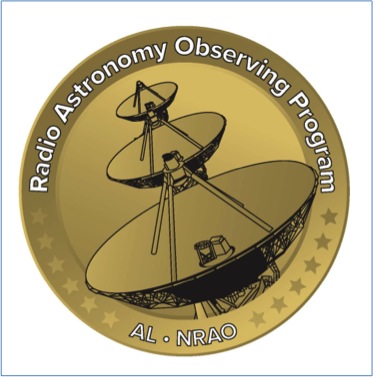
Do you know an amateur astronomer looking for a new observing challenge, or perhaps a student looking for a unique science fair project? Or maybe you are a K through college educator looking for space science related projects to engage your students, or ways to integrate engineering practices into your curriculum? The largest coalition of amateur astronomy organizations in the world, the Astronomical League (AL), and NRAO have teamed up, with support from Associated Universities Inc., to begin a new astronomy “badge” program. You may have gazed at the stars, enjoyed meteors streaking across the sky, or looked at Jupiter through a telescope, but most people do not think about the invisible Universe we miss by using our eyes alone. Unlike traditional AL observing programs, the new Radio Astronomy Observing Program (RAOP) encourages explorers of all ages to gaze to the cosmos and “see” the invisible radio Universe.
The RAOP is designed to introduce and encourage observations in the radio part of the electromagnetic spectrum, as well as the construction of radio telescopes and observing instruments. RAOP focuses on five major observing projects: (1) space weather, (2) the Sun, (3) Jupiter, (4) meteors, and (5) Galactic radio sources. Each of the projects can be completed using NRAO or other professional radio telescopes, or instruments built by individulas or the RAOP teams.
Projects range from beginner to advanced levels, and are open to amateur astronomers, K through college educators, and learners of all ages. The AL will award participants a RAOP bronze certifticate for completing a single observing project, or a RAOP silver certificate and pin for completing two projects. The AL will award the RAOP gold certficiate and pin to those who complete four observing projects.
In addition to getting people to think about astronomy in a new “light”, the RAOP can help bring together educators and amateur astronomers to address critical needs in science, technology, engineering, and mathematics (STEM) education. The U.S. Federal STEM 5-Year Strategic Plan calls for the U.S. to “increase and sustain youth and public engagement in STEM by supporting a 50% increase in the number of U.S. youth who have an authentic STEM experience each year prior to completing high school.” In addition, the Next Generation Science Standards (NGSS) call for the integration of engineering practices in K-12 science learning. Amateur astronomers are known for their excellent education and public outreach work, and through the AL’s 10,000+ members, and collaboration with NRAO, the new RAOP will work to address these national priorities.
Explore the new Radio Astronomy Observing Program online.
Recent Media Releases
Career Opportunities
New Postings
Co-Op Student (Technical): The NRAO in Socorro, NM is now accepting applications for a Co-Op Student position. Assignments typically involve computer programming, electronic design and/or testing. This particular work assignment will involve performing RFI and EMC testing at the Very Large Array, as well as general EVLA receiver maintenance and installation. Tasks will include the collection, analysis and presentation of monitoring system data, the location, identification and mitigation of detected RFI, and performing RF power measurements in a RF reverberation chamber.
Project Manager II (841): The NRAO is now accepting applications for a Project Manager in Socorro, NM. The Project Manager will take a leadership role and serve as a change agent in the implementation of all PM standards, processes, tools, techniques, and support services in New Mexico.
Project Manager II (842): The NRAO is now accepting applications for a Project Manager in Socorro, NM. The Project Manager will provide (software) project management for CASA and CASA based pipelines. Other Data Management Software Development (DMS) projects, including externally funded ones, will also be supported as time and priority allows.
Telescope Mechanic I: The NRAO is now accepting applications for a Telescope Mechanic at the Very Large Array, 50 miles west of Socorro. Under general supervision, the Telescope Mechanic will perform tasks associated with maintenance and servicing radio telescope mechanical components.
Scientific Associate (Data Analyst): The NRAO in Charlottesville, VA is now accepting applications for a Data Analyst position. The primary goal of the Data Analyst will be to provide assistance to observatory users by reducing data and assessing data quality, operating a data reduction pipeline, answering questions in the online helpdesk system, assisting with observing script preparation, testing observatory software, and contributing to the data delivery process.
System Administrator II: The NRAO in Socorro, NM is now accepting applications for a Systems Administrator position. Under the guidance of the SIS HPC group lead this position will work with local technical and scientific staff to improve the state of local and remote Linux cluster based parallel processing. Duties will include assisting with implementation of automated routine benchmarking of standard NRAO analysis packages, assisting in the creation of archive, cluster, Lustre file system and Wide Area Network (WAN) monitoring and scheduling tools, and the creation of user documentation.
Software Build and Test Engineer: The NRAO is now accepting applications for a Software Build and Test Engineer. This position may be located in Socorro, NM or Charlottesville, VA. The Software Engineer will be a member of the Common Astronomy Software Applications (CASA) development team. The new team member will primarily be responsible for CASA builds, build support and release packaging. As part of these duties, the Software Engineer will participate in extending the current build system (currently based on Cmake) and the existing automated test system (currently based on Jenkins and Robot Framework).
From the Archives
Ellen Bouton

[click to enlarge]
About this month's photograph: On Sunday, 2 November 2014, Astrophytness, the NRAO wellness program, will again sponsor the "Hein Hvatum Memorial VLA Bicycle Challenge," a bicycle ride from Socorro to the VLA site and back (with several options for shorter rides). Hein Hvatum, long-time NRAO Associate Director, was an avid bicycler through his entire life. For many years, he organized the annual ride over 117 mountainous miles from Charlottesville to Green Bank for the Green Bank summer picnic: Charlottesville to Green Bank on Friday, picnic on Saturday, Green Bank to Charlottesville on Sunday. (See From the Archives in the 29 July 2010 NRAO eNews for a photo of the 1984 riders to Green Bank). In 1999, a small NRAO group biked a part of the Continental Divide Trail. This photo, taken by cyclist Craig Walker, shows Peter Napier, Hein Hvatum (long-retired by 1999), and Gene Runion on one of the smoother parts of the trail. Thanks to Craig Walker for the photo.
From the Archives is an ongoing series illustrating NRAO and U.S. radio astronomy history via images selected from our collections of individuals' and institutional papers. If readers have images they believe would be of interest to the Archives, please contact Ellen Bouton, archivist@nrao.edu.

